1.ToDictionary,ToLookup
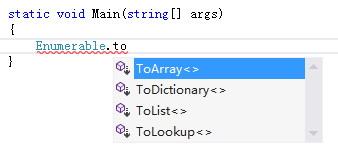
从图中我们看到有四个ToXXX的方法,其中ToArray和ToList,用的是非常非常多
我们有这样的一个实体
class student { public string StuNo { get; set; } //学号 public string Grand { get; set; } //年级 public string Sex { get; set; } //性别 }
年级和学号是一对多的关系,也就是说一个年级可能包含几个学号,每个学号都有自己对应的性别
class Program { static void Main(string[] args) { } public static List<student> GetList() { return new List<student>() { new student(){StuNo="0001",Grand="一年级",Sex="男"}, new student(){StuNo="0002",Grand="二年级",Sex="男"}, new student(){StuNo="0003",Grand="一年级",Sex="女"}, new student(){StuNo="0004",Grand="一年级",Sex="男"}, new student(){StuNo="0005",Grand="二年级",Sex="男"}, new student(){StuNo="0006",Grand="一年级",Sex="女"}, new student(){StuNo="0007",Grand="二年级",Sex="男"}, new student(){StuNo="0008",Grand="一年级",Sex="男"}, new student(){StuNo="0009",Grand="二年级",Sex="女"}, new student(){StuNo="0010",Grand="一年级",Sex="男"}, new student(){StuNo="0011",Grand="三年级",Sex="女"}, new student(){StuNo="0012",Grand="一年级",Sex="人妖"}, new student(){StuNo="0013",Grand="三年级",Sex="女"} }; } }
这种初始化类对象的方法以及返回方式:
student s= new student() { Sex = "nan" };
举个例子: 我需要统计各个年级中的学号情况。
很明显,这是一个分组排序的问题,可能你马上就想起了groupby来实现,当然groupby是可以实现的,不过groupby不能算是一种数据结构,不能带有索引,没有字典那样容易输出和操作。
方案一: 采用普通的foreach循环。
一般情况下,可能有一部分人都采用这种原始的方法,将list数据通过foreach循环放到dictionary中,就是代码写的多一些,也算是最灵活的。
static void Main(string[] args) { Dictionary<int, student> dic = new Dictionary<int, student>(); List<student> stulist = GetList(); foreach (var item in stulist) { if (!dic.ContainsKey(item.Grand)) { dic.Add(item.Grand, item); } else { dic[item.Grand] = item; } } }
结果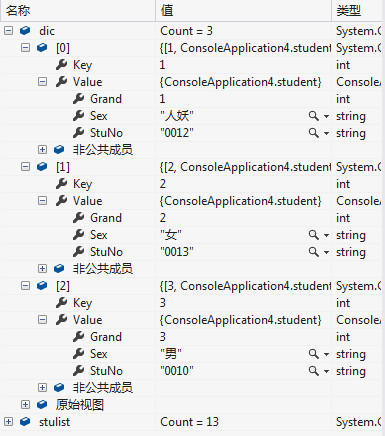
方案二:使用ToDictionary
Dictionary是一种键值方式(值是一个对象)

从图中我们可以看到,发生悲剧的异常了,我们知道dictionary中key是不能重复的,然而ToDictionary中并没有给我们做key的重复值判断,那也就侧面说明ToDictionary在kv中只能是 “一对一”的关系,也就是v中永远只会有一条记录,显然这不是我需要的,在了解ToDictionary原理后,该方案失败。
如果没有重复的
class Program { static void Main(string[] args) { List<student> stulist = GetList(); var dic = stulist.ToDictionary(m=>m.Grand); } public static List<student> GetList() { return new List<student>() { new student(){StuNo="0001",Grand=1,Sex="男"}, new student(){StuNo="0002",Grand=2,Sex="男"}, new student(){StuNo="0003",Grand=3,Sex="女"}, }; } }
结果是
Dictionary的下标只能是键
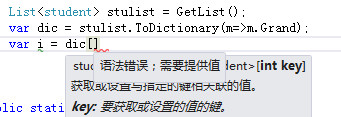

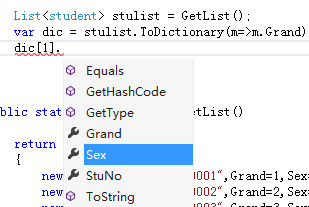
方案三: 使用ToLookup(键值对,值是一组对象)
ToDictionary的加强版,可以认为是一种新的字典数据结构,它就避免了这种“一对一”的关系,采用“一对多”的实现。
static void Main(string[] args) { var stulist = GetList(); var dic = stulist.ToLookup(i=>i.Grand); foreach (var item in dic) { Console.WriteLine("年级:" + item.Key); foreach (var item1 in item) { Console.WriteLine(" " + item1.StuNo + " " + item1.Sex); } } }
结果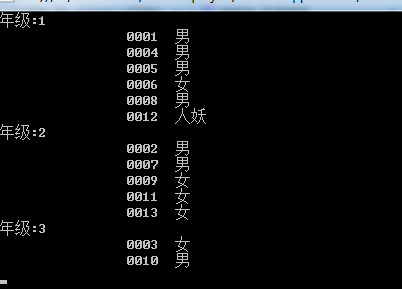
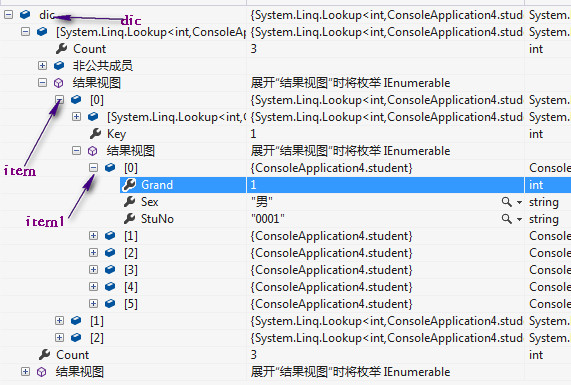
而且ToLookup和字典一样,是带有索引形式,这个groupby就不具备了,当然Tolookup还有一个强大的功能,就是使用Func<TSource, TElement> elementSelector来对现在的v元素进行转换来避免刚才 Console.WriteLine(" " + item1.TicketNo + " " + item1.Description);语句
static void Main(string[] args) { var stulist = GetList(); var dic = stulist.ToLookup(i => i.Grand, j => { return j.StuNo + " " + j.Sex; }); foreach (var item in dic) { Console.WriteLine("年级:" + item.Key); foreach (var item1 in item) { Console.WriteLine(" "+ item1); } } }
输出同样的结果
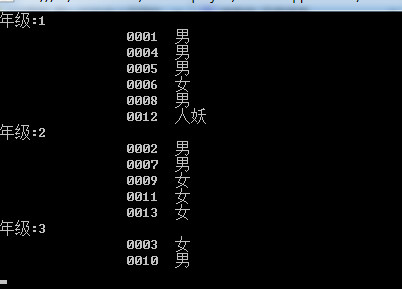
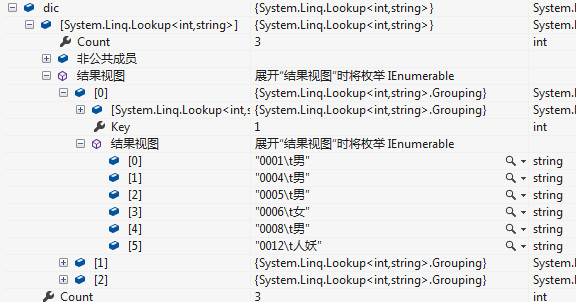
2.键值对集合

SortedList<TKey, TValue>( ) 表示根据键进行排序的键/值对的集合,而键基于的是相关的 IComparer<T> 实现。
SortedDictionary<TKey, TValue>() 表示根据键进行排序的键/值对的集合。
使用KeyValuePair对其进行遍历
SortedList<int, string> sortedList = new SortedList<int, string>(); foreach (Value val in enumValues) { sortedList.Add(Convert.ToInt32(val.EnumValueIndex), val.EnumValueName); } foreach (KeyValuePair<int, string> e in sortedList) { string strName = e.Value; SelectListItem myli = new SelectListItem { Text = strName, Value = e.Key.ToString(), Selected = (e.Key == value) }; cpType.Add(myli); }